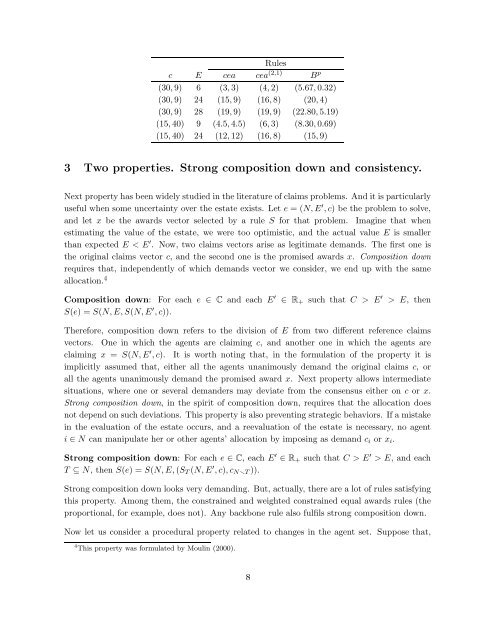STRONG COMPOSITION DOWN. CHARACTERIZATIONS OF ... - Ivie
You also want an ePaper? Increase the reach of your titles
YUMPU automatically turns print PDFs into web optimized ePapers that Google loves.
Rules<br />
c E cea cea (2,1) B p<br />
(30,9) 6 (3,3) (4,2) (5.67,0.32)<br />
(30,9) 24 (15,9) (16,8) (20,4)<br />
(30,9) 28 (19,9) (19,9) (22.80,5.19)<br />
(15,40) 9 (4.5,4.5) (6,3) (8.30,0.69)<br />
(15,40) 24 (12,12) (16,8) (15,9)<br />
3 Two properties. Strong composition down and consistency.<br />
Next property has been widely studied in the literature of claims problems. And it is particularly<br />
useful when some uncertainty over the estate exists. Let e = (N,E ′ ,c) be the problem to solve,<br />
and let x be the awards vector selected by a rule S for that problem. Imagine that when<br />
estimating the value of the estate, we were too optimistic, and the actual value E is smaller<br />
than expected E < E ′ . Now, two claims vectors arise as legitimate demands. The first one is<br />
the original claims vector c, and the second one is the promised awards x. Composition down<br />
requires that, independently of which demands vector we consider, we end up with the same<br />
allocation. 4<br />
Composition down: For each e ∈ C and each E ′ ∈ R + such that C > E ′ > E, then<br />
S(e) = S(N,E,S(N,E ′ ,c)).<br />
Therefore, composition down refers to the division of E from two different reference claims<br />
vectors. One in which the agents are claiming c, and another one in which the agents are<br />
claiming x = S(N,E ′ ,c). It is worth noting that, in the formulation of the property it is<br />
implicitly assumed that, either all the agents unanimously demand the original claims c, or<br />
all the agents unanimously demand the promised award x. Next property allows intermediate<br />
situations, where one or several demanders may deviate from the consensus either on c or x.<br />
Strong composition down, in the spirit of composition down, requires that the allocation does<br />
not depend on such deviations. This property is also preventing strategic behaviors. If a mistake<br />
in the evaluation of the estate occurs, and a reevaluation of the estate is necessary, no agent<br />
i ∈ N can manipulate her or other agents’ allocation by imposing as demand c i or x i .<br />
Strong composition down: For each e ∈ C, each E ′ ∈ R + such that C > E ′ > E, and each<br />
T ⊆ N, then S(e) = S(N,E,(S T (N,E ′ ,c),c NT )).<br />
Strong composition down looks very demanding. But, actually, there are a lot of rules satisfying<br />
this property. Among them, the constrained and weighted constrained equal awards rules (the<br />
proportional, for example, does not). Any backbone rule also fulfils strong composition down.<br />
Now let us consider a procedural property related to changes in the agent set. Suppose that,<br />
4 This property was formulated by Moulin (2000).<br />
7

















